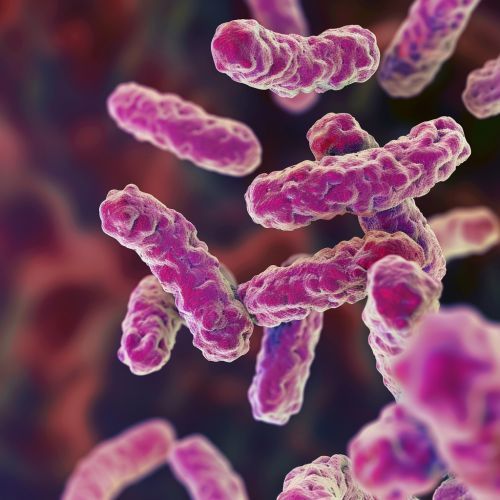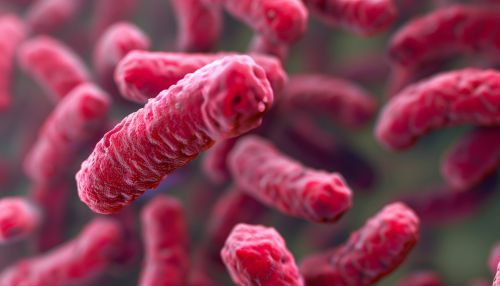Bordetella pertussis: Difference between revisions
(Created page with "==Introduction== Bordetella pertussis is a Gram-negative, aerobic bacterium of the genus Bordetella. It is the causative agent of pertussis, also known as whooping cough, a highly contagious human respiratory infection. The bacterium is named after the Belgian bacteriologist Jules Bordet, who first isolated it in 1906. <div class='only_on_desktop image-...") |
No edit summary |
||
| (One intermediate revision by the same user not shown) | |||
| Line 2: | Line 2: | ||
[[Bordetella pertussis|Bordetella pertussis]] is a [[Gram-negative bacteria|Gram-negative]], [[aerobic bacteria|aerobic]] bacterium of the genus [[Bordetella|Bordetella]]. It is the causative agent of [[pertussis|pertussis]], also known as whooping cough, a highly contagious human respiratory infection. The bacterium is named after the Belgian bacteriologist [[Jules Bordet|Jules Bordet]], who first isolated it in 1906. | [[Bordetella pertussis|Bordetella pertussis]] is a [[Gram-negative bacteria|Gram-negative]], [[aerobic bacteria|aerobic]] bacterium of the genus [[Bordetella|Bordetella]]. It is the causative agent of [[pertussis|pertussis]], also known as whooping cough, a highly contagious human respiratory infection. The bacterium is named after the Belgian bacteriologist [[Jules Bordet|Jules Bordet]], who first isolated it in 1906. | ||
[[Image:Detail-79081.jpg|thumb|center|Close-up view of Bordetella pertussis bacteria.|class=only_on_mobile]] | |||
[[Image:Detail-79082.jpg|thumb|center|Close-up view of Bordetella pertussis bacteria.|class=only_on_desktop]] | |||
==Characteristics== | ==Characteristics== | ||
Latest revision as of 00:09, 17 May 2024
Introduction
Bordetella pertussis is a Gram-negative, aerobic bacterium of the genus Bordetella. It is the causative agent of pertussis, also known as whooping cough, a highly contagious human respiratory infection. The bacterium is named after the Belgian bacteriologist Jules Bordet, who first isolated it in 1906.


Characteristics
Bordetella pertussis is a small, encapsulated coccobacillus. It is non-motile and does not form spores. The bacterium is strictly aerobic and oxidase-positive. It has a complex nutritional requirement, needing nicotinamide and other growth factors for its cultivation. The bacterium is capable of surviving in the environment for many days, but its primary habitat is the ciliated epithelium of the human respiratory tract.
Pathogenesis and Clinical Features
The pathogenesis of Bordetella pertussis involves several stages. Initially, the bacterium attaches to the cilia of the respiratory epithelial cells, causing local inflammation and damage. This is followed by the production of several toxins, including pertussis toxin, adenylate cyclase toxin, and tracheal cytotoxin, which contribute to the clinical manifestations of the disease.
The clinical features of pertussis are characterized by three stages: the catarrhal stage, the paroxysmal stage, and the convalescent stage. The catarrhal stage is characterized by symptoms similar to those of a common cold, such as runny nose, low-grade fever, and mild cough. The paroxysmal stage is marked by severe and uncontrollable coughing fits, often followed by a high-pitched "whoop" sound during the intake of breath, hence the name "whooping cough". The convalescent stage is the recovery phase, which may last several weeks or even months.
Diagnosis and Treatment
Diagnosis of pertussis is usually based on clinical symptoms and confirmed by laboratory tests. The gold standard for laboratory diagnosis is culture of the bacterium from nasopharyngeal swabs or aspirates. However, due to the fastidious nature of the bacterium, culture is often difficult and time-consuming. Therefore, molecular techniques such as polymerase chain reaction (PCR) are increasingly used for rapid and accurate diagnosis.
Treatment of pertussis involves supportive care and antibiotic therapy. The antibiotic of choice is usually a macrolide such as erythromycin, azithromycin, or clarithromycin. Early treatment can reduce the severity of symptoms and prevent the spread of the disease to others. However, once the paroxysmal stage has begun, antibiotic therapy has little effect on the course of the disease.
Prevention
Prevention of pertussis is primarily through vaccination. The pertussis vaccine is usually given in combination with diphtheria and tetanus vaccines (DTaP or Tdap). The vaccine is highly effective in preventing the disease, but its protection wanes over time, necessitating booster doses.
Epidemiology
Pertussis is a global disease, affecting all age groups. However, it is most severe in infants and young children. Despite widespread vaccination, pertussis remains a significant public health problem, with periodic epidemics occurring worldwide.
Research and Future Directions
Research on Bordetella pertussis is focused on understanding its pathogenesis, improving diagnostic methods, and developing more effective vaccines. Future directions include the development of new vaccines that provide longer-lasting immunity and the use of genomic and proteomic technologies to better understand the biology of the bacterium.
